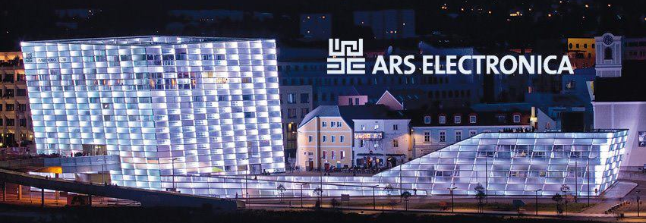
Living meanwhile quite close time, it was time again visiting the Ars Electronica Center in Linz, Austria.
But? – What exactly is this?
In fact, it may not be a concrete definition in my mind that could sum it up in the most perfect way, but if someone asks, I usually reply: “It is a museum for computers, future technology and such.”

Dealing with those topics and due to that fact that H.W. Franke, certainly the most famous Austrian science-fiction author (most likely even among the top 10 European SF-authors alive), is one of the founders, it is no wonder that it is a top destination for science-fiction fans! - Though the target group are in fact not mainly “we nerds”, but especially families and school classes as well as on international tourists.
Visiting Linz, the building is hard to miss, especially at night. It is suitated next to the Nibelungenbrücke (a bridge over the Danube, connecting the two parts of the city) and the futuristic design is quite noticeable. After nightfall the glass front lights up in changing colours.
The Center itself had been founded in 1989, but before that from 1979 on, already an event called Ars Electronica, a festival for digital art set place. It still exist as an annual event that drows a lot of visitors to Linz. It was enhanced in 2009 when Linz had been European Capital of Culture.
But being there, what to expect? – In fact, the people there join a lot of interesting projects, but what did I see being there?
Well, it is a museum. A place to learn about the history, e.g. on computers, the internet. About current topics like climate change. A lot of objects can be touched, flipped around, and create new images while doing so.

Or the possibilities of robot technology. For one example they have a rebot pet seal with an artificial intelligence that reacts to stroking. They have not developed it as a plain toy, but probably for elderly people who cannot care for a pet anymore and may be limited in their other social interactions as well. The seal was chosen, as everyone perfectly knows how a cat or dog usually behaves, so there are higher expetations on a “natural” behaviour.
And it also an art gallery that shows works of artists, using new media and new technologies, such a 3D-print.

And of course: A playground!
It is quite easy spending some hours, looking and trying out, so in case you think that the entrance is high, I can tell you that is definitely worth it. Besides that, there are various changing presentations on various topics. Most of them are of course in German as it is the only official language in Austria. But the highlight at this time, the Deep Space 8K also offeres presentations in English language every day. (So in case you travel to Linz and visit the Ars Eletronica, I would recommend you to check out the current program on the internet first to know if you e.g. should come early or have lunch first. Though by the way: There is also a restaurant bar with a great view inside.)
But back to the topic: This main presentation is really something every visitor should see! It is a show on a 16 by 9 meters wall and 16 by 9 meters floor projection, laser tracking and 3-D animations. 8K? - Yes, the name comes from the resultion of the pictures shown, it is 8K, or more exactly, 8.192 × 4.320 pixels. I have seen the highlight show in English this time. Especially the viewing into space, zooming into and beyond our galaxy is an amazing experience and certainly the highlight of the whole Ars Electronica.

